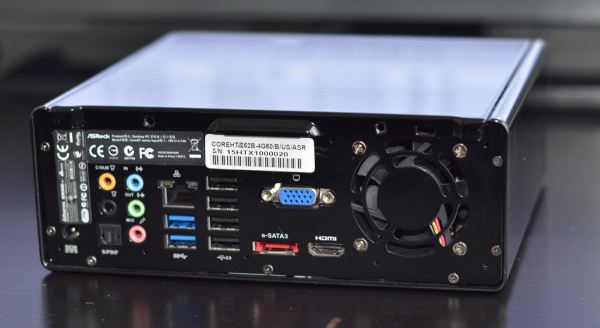ASRock CoreHT Server Edition Review
by Vivek Gowri on February 16, 2012 9:00 AM EST- Posted in
- Systems
- Intel
- ASRock
- Media Streamer
- HTPC
Introduction
Late last year, we took a look at the ASRock CoreHT 252B, a Sandy Bridge-based midrange HTPC. We liked the CoreHT quite a bit, noting that the small form factor HTPC was a solid choice for most users in this segment. It was hit all the key points, though it didn’t do anything in particular to set itself apart from the rest of the SFF crowd. Our main complaints centered around the hard drive performance, and to that end comes the ASRock CoreHT Server.
It’s very similar to the CoreHT we reviewed before, even sharing nearly the same specs. The one major difference: there’s two 500GB HDDs in the place of one, configured in RAID 0. Other than that, there’s the same mobile Sandy Bridge internals, headlined by the HM67 chipset and Core i5-2410M processor.
| ASRock CoreHT Server Edition HTPC Specifications | |
| Processor |
Intel Sandy Bridge Core i5-2410M (2 x 2.30 GHz (2.90 GHz Turbo), 32nm, 3MB L2, 35W) |
| Chipset | Intel HM67 |
| Memory | 2 x 2GB DDR3-1333 |
| Graphics |
Intel HD Graphics 3000 650 MHz / 1.2 GHz (Turbo) |
| Hard Drive(s) |
2 x 500GB 7200RPM 2.5" HDD (RAID 0) (Western Digital Scorpio Black WD5000BEKT, Hitachi HTS7250) |
| Optical Drive | Blu-ray/DVDRW Combo |
| Networking |
Gigabit Ethernet 802.11b/g/n (2T2R Atheros AR5B97 in AzureWave AW-NE121H mini-PCIE card) |
| Audio |
Microphone and headphone/speaker jacks Capable of 5.1/7.1 digital output with HD audio bitstreaming (optical SPDIF/HDMI) |
| Operating System | Windows 7 Ultimate 64-bit (Retail unit is barebones) |
| Extras |
THX TruStudio Pro Audio Certification IR receiver and MCE remote |
| Pricing | TBD |
ASRock’s Core HTPC line is their midrange model, slotting between the entry level ION-based machines and the high-end Vision 3D units. The Server is externally exactly the same as the 252B, so I’ll refer you back to that review for more details on the unboxing experience. The CoreHT case is glossy black, mostly angular, but the industrial design is understated and fits well in an A/V cabinet. I like the two USB 3.0 ports on the front, as well as the understated nature of the design. The industrial design isn’t premium by any means, but it’s generally inoffensive and doesn’t bring attention to itself, which is perhaps the most important visual trait for an HTPC.
There’s a decent array of ports on the back, with four USB 2.0 ports, another pair of USB 3.0 ports, eSATA, SPDIF, Gigabit Ethernet, VGA, and of course HDMI. Cooling is handled with an intake vent on the front of the system and a small exhaust fan at the back.












44 Comments
View All Comments
Bejusek - Thursday, February 16, 2012 - link
I admit that 1TB is scarce, but 18TB is a bit of overkill for me. Your words only confirm my opinion that 'server edition' is a joke.Metaluna - Friday, February 17, 2012 - link
Not just 1TB, but 1TB in Raid 0. As in, even less reliable than a single 1TB drive, just to gain a bit of performance that has questionable benefit in a small file server anyway. In other words, they don't get it.The name is probably just marketing, to align it with the Mac Mini Server, which also has two hard drives.
faizoff - Thursday, February 16, 2012 - link
The idle CPU temp seems a bit high though honestly I don't know the expected standard for HTPCs. My i5 2500k idles at 29-32 C, I'd always assumed HTPCs idle at around the same or less.Death666Angel - Thursday, February 16, 2012 - link
Considering that this temp does not negatively affect anything (like performance, life span etc.) it is really not interesting. They probably made the decision to go with more lenient fan controls. Nothing wrong with that. :-)faizoff - Thursday, February 16, 2012 - link
Well it was interesting to me since at idle in an HTPC there are a lot less resources running when compared to a desktop. Plus I always thought they would consume less power and generate less heat when compared to a desktop.Just some assumptions I formed I guess.
Death666Angel - Thursday, February 16, 2012 - link
Less power and therefore less heat, sure. But also small enclosure, smaller heatsinks, smaller fans etc. Those things go together, so just less heat doesn't mean lower temps. Just look at small notebooks with 35W CPUs, they regularly have higher temps than 95W desktop CPUs. :-)duploxxx - Thursday, February 16, 2012 - link
From the first review it was already clear that the Intel onboard GPU is just not up to the task to fully utilize where a HTPC is build for, this update doesn't change anything, hence even don't understand why bother to review again, There are other platforms much better suited then this. On top of that why bother with those few benchmarks, the cpu is know for a long time, these benchmarks are no real added value.Scannall - Thursday, February 16, 2012 - link
Without a way to put better graphics in it, I am wondering why they didn't go with a mobile Llano CPU instead.queequeg99 - Thursday, February 16, 2012 - link
Maybe they're thinking that heavy duty transcoding is more important than casual gaming for the intended audience. I ran into the same choice a few months ago. Fortunately, all of my video files are in a single format and no transcoding is necessary with the software I use. However, I would like the ability to play the occasional game of Portal. The A8-3850 works perfectly for that purpose.capeconsultant - Thursday, February 16, 2012 - link
What is up with that?